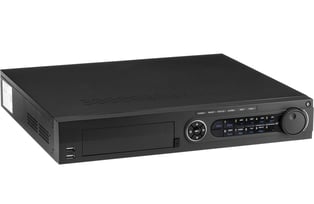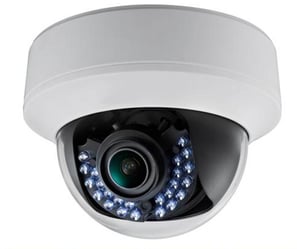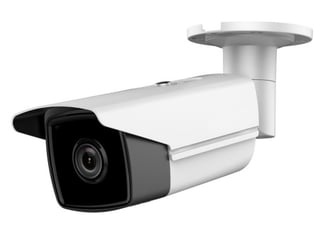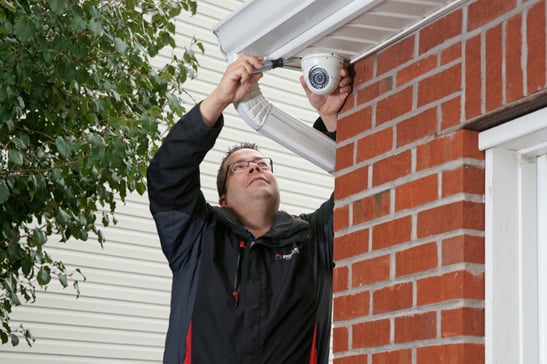When deciding to purchase video surveillance cameras, there are several items that should be considered before making the final investment. Today's video surveillance solutions are not the same as they were even as little as a year ago because the technology in the industry moves very quickly. In most cases, unless you are active in the industry, your knowledge base becomes irrelevant within just a few months. It's important to consider wiring, camera selection, supplemental lighting, analytic processing, resolution and the type of technology that would best suit your needs when designing a camera system. Let's cover some of the most common areas of concerns for people attempting to select the best video surveillance solution for their specific needs.
What's better, analog or IP?
When it comes to video surveillance there are two technologies utilized for image transmission. One is the original analog technology (coax wire) and the other is IP (internet protocol using category 5 or 6 wire). A few years ago, it was a simple decision. If you wanted high resolution video you were limited to IP. Analog video did not deliver when it came to excellent video quality. That has changed considerably. Image resolution as high as 8 Megapixel (4K video) is readily available to be purchased to run on legacy coax wire.
So, what’s the right answer?
Let's look at some details. Both IP and analog cameras can compress very high-resolution video, both have access to analytics, both can support smart features like control for pan, tilt and zoom cameras without the addition of extra communication wires. And technically speaking, both technologies have converters to allow them to be transmitted over one another's wire. So, why do they both exist? A colleague of mine put it best, "Proximity to the Hard Disc Drive."
To keep it as simple as possible, Internet Protocol cameras were exclusively designed to support better data transmission over great distances and scale far better for large systems. However, analog video is far more attractive for long term service. It's very easy to update a digital video recorder (DVR) when one fails without replacing cameras, but when you have an IP video system and a network video recorder (NVR) fails, it is far more challenging to replace just the NVR or a single camera as the firmware in all of the equipment must be a close match or the entire system will be unstable and require a complete replacement. Something as simple as not having the camera password can make a full system replacement a necessity. To this day and as far as I can see, there will always be a place for both technologies. The take-away here is that this is a conversation not an open and shut case as to which technology is right for you.

Multi-Channel DVR
What is ONVIF and how could it affect my video system?
If you select analog high definition security cameras for your next system individual component failures present little to no replacement concerns. The standardization of analog technology makes servicing the system very simple and cost effective. Just plug in the new part(s) and it works. However, if you select an IP solution and several years down the road you have a failure, it can be very challenging to get the system back up and running. You will be required to know camera passwords and have firmware that is very similar. It was such a problem early on in the IP camera industry that the global community got together and decided that they needed a standardization to try and take some of the proprietary nature out of IP video systems. ONVIF stands for Open Network Video Interface Forum. It is an attempt to standardize the integration between individual parts in a network video solution.
So, how did this attempt at standardization work?
Not so good, actually. Right now, there are six profiles, S, C, G, Q, A, and T. Many of these profiles do not crosstalk, older versions of one profile may not work with a newer version of the same profile. It is far from standardized or simple.
What is the best that we can hope for when designing solutions utilizing ONVIF profiles?
When I deal with ONVIF, my highest expectation is that I get an image.

Dome Security Camera
But, what about motion detection and dual streaming?
Two critical functions for anyone who owns a video surveillance product would be motion detection and dual streaming. Motion detection allows you to find events quickly without reviewing countless hours of idle video and dual streaming allows low resolution video to reach your cell phone for remote view while simultaneously recording at very high resolutions. In my estimation, ONVIF is fantastic idea that falls very short of providing a dependable solution for long term service and integration of critical video surveillance appliances. With that said, before you jump right into an IP video solution because your perception is that it is better or your network administrator won’t entertain any solution that is not IP driven take a moment to ask yourself how important it will be to integrate down the road with replacement equipment when needed.
How do I pick a camera?
There is a common problem in the video surveillance industry. People try to do far too much with a single camera. Technically speaking, video surveillance design begins with a pixel-per-foot minimum for any given camera viewing area to be able to clearly see what will be required when an event occurs. Step two is to plan for adequate lighting to support that required image during low light times of the day. Unfortunately, most people don't take the time to understand the technology beyond a sale flyer. Unless your solution includes placing a box store kit system inside of a single 15’ x 20’ room, in most cases it will not perform when required. Simple things like lens selection can make all the difference in the performance of a system. Some high-performance cameras see far better at night than others and what about low-light cameras? Selecting a camera to see what you need to see, when you need to see it goes far beyond a one-size-fits-all system that includes four identical bullet cameras in a box. There are specialized cameras like fish-eye or also known as surround cameras, Pan-Tilt-Zoom cameras with motors. There are also cameras with multiple processors in one housing covering different views. All of these specialized cameras can be very costly and many times sold with a little too much hype.
You can compare cameras to the individuality of people. Some create imagery better at night, some better during the day, some camera chassis are more appropriate for wall mounting and others are better for mounting on a ceiling. In the end, camera selection is a conversation with a professional who has years of experience and practices in the industry daily. Don’t put your confidence in a product document; place your confidence in a person with direct experience with the equipment you are considering who can tell you specifically the plus or minus to any given camera technology.
 Bullet Security camera
Bullet Security camera
I already have a system but I can't see it on my smart device remotely anymore, what good is that?
The two main reasons people prematurely replace their video system is a lack of support and poor installation procedures that lead to failed or damaged equipment. It is quickly becoming a throw-away world. The phone technology changes monthly, Microsoft Windows updates are distributed weekly, platforms come and go. If you are not a trained network administrator you will struggle to keep up with the necessary programming required to maintain a constant connection with your video surveillance system. If you need a video surveillance system and you need to be connected to it remotely then you should only be working with a Security Company that can provide the long-term support required to maintain the equipment and your connectivity to that equipment. A properly installed system will function for many, many years. To take full advantage of your investment it is important to work with professionals like Doyle Security that can keep your equipment integrated as long as possible.
Can I get smart cameras that notify me when things happen?
Surveillance video systems can make decisions about what they see and then notify you. The video surveillance industry has a name for that process and that name is analytics. Analytics are nothing more than software programs that look at the image as it changes and try to determine if these changes are a vehicle, person, a predetermined direction of travel, an unattended object and/or a long list of other activities. Analytics should not be confused with basic motion detection. Motion detection simply looks for color change in the image. For example: When vehicles drive by your home at night their headlights can reflect inside the home and the motion detection cameras will begin to record but a true analytic driven camera will not be fooled by the headlights. Analytics can be very expensive and are not perfect. The simpler the activity and the smaller the region to surveil, the more affordable and accurate the analytic will be. For example: Determining if there is a person in your front yard is much easier than determining if there is a person in a large field. Any thoughts about analytics should include acceptance of some level imperfection. They will be very good, but not perfect.
Can anyone just install my cameras?
In the state of New York, it is illegal for anyone without a State of New York low voltage license to install video surveillance cameras. The licensing procedure requires many course hours and frequent on-going education along with licensing fees. The proper installation of a video system will include running wires and drilling holes in your home or business. These holes need to be sealed or in the winter the warm air will follow the wire out of the building and into the camera where that warm are will condense, freeze and turn the camera into a block of ice. The exterior connections must be kept in a weather resistant area and many times coated with dielectric grease. The recorder should be installed in an area that is free from dust and dirt and not have any ventilation restrictions. The list of good practices is much longer than this. It’s very easy to make a camera system work for several months, but to make one work for many years requires attention to detail and excellent installation practices and to be legal, a New York State installation license.

Can’t I just buy some wireless cameras?
Wireless cameras inside of a small office or home are designed to connect to a recorder using the WIFI signal on your in-home WIFI system or by using their own proprietary wireless signal using transceivers. It is very hard to install a wireless system that works for many years without issue. Often the cameras will fail to perform because the signal is competing with all other WIFI appliances in your small office or home. To avoid this issue, our technicians can create prioritization in your router but that is not an option that all routers have. Routers that support prioritization and have the necessary resources to handle the heavy traffic from WIFI cameras can be very costly; you can expect to spend over $350.00 on just the router. This expensive router does not guarantee that you can place these cameras anywhere in your home or office, many times the signal is lost if it must penetrate more than one wall, or if it is more than 30 feet away, line of site. This solution also does not eliminate wires as it is necessary to power the cameras. Due to the challenges involved in WIFI cameras and the high level of failure after a relatively short shelf life, I generally recommend the use of a hard-wired system which allows for proper suppression, battery backup and long-term service life with simple and easy replacement or updates to individual items down the road.
Not to be confused with WIFI (short range and unpredictable wireless video technology), is a wireless technology that supports linking multiple buildings together to create one video solution that spans over multiple structures, or a structure and a pole, or multiple sites with reasonable line of site many miles apart. This technology is very predictable and provides a stable, long term solution for transmitting large numbers of cameras over great distances instantly. Doyle Security specializes in camera systems that span multiple buildings or structures to create a large campus style video system. This wireless technology is commonly known as a dedicated bridge, point to point or point to multi-point wireless connection and it is highly recommended when needed.
How do I move forward?
Doyle Security has people who have been trained to help you find your way through all of this available technology to find the place where the equipment and installation costs can meet your budget. Our focus is to provide you with excellent value. The value of a system that works today, tomorrow and into the future with the necessary support to keep that investment integrated and serviceable. The most expensive system you can buy is one that needs to be replaced prematurely, so let’s do it right, the first time.
The opinions expressed in this article are those of the author and are not necessarily shared by Doyle Security Systems, Inc.

